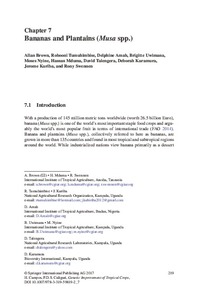| dc.contributor.author | Brown, A. |
| dc.contributor.author | Tumuhimbise, R. |
| dc.contributor.author | Amah, D. |
| dc.contributor.author | Uwimana, B. |
| dc.contributor.author | Nyine, M. |
| dc.contributor.author | Mduma, H. |
| dc.contributor.author | Talengera, D. |
| dc.contributor.author | Karamura, D. |
| dc.contributor.author | Kuriba, J. |
| dc.contributor.author | Swennen, R.L. |
| dc.date.accessioned | 2019-12-04T11:10:56Z |
| dc.date.available | 2019-12-04T11:10:56Z |
| dc.date.issued | 2017 |
| dc.identifier.citation | Brown, A., Tumuhimbise, R., Amah, D., Uwimana, B., Nyine, M., Mduma, H., ... & Swennen, R. (2017). Bananas and plantains (Musa spp.). In H. Campos, and P.D.S. Caligari, Genetic improvement of tropical crops (p. 219-240). Cham, Springer. |
| dc.identifier.isbn | 978-3-319-59817-8 |
| dc.identifier.uri | https://hdl.handle.net/20.500.12478/2308 |
| dc.description | Published online: 31 October 2017 |
| dc.description.abstract | Bananas and plantains are one of the most important crops in the world, yet very few hybrids are cultivated. Bananas face considerable pressure from multiple biotic and abiotic stresses, but its genetic improvement is impeded by constraints on seed set due to multiple physiological and reproductive issues. The triploid nature of almost all commercially important bananas requires a complicated breeding scheme involving cross hybridization across ploidy levels and results in poor seed set that reduces the probability of obtaining favorable recombination. The poor seed set is further complicated by issues of parthenocarpy and partial to complete female and male sterility that are not fully understood. While the introduction of genomic resources of this perennial long cycling crop promises to hasten the development of improved cultivars, there is a need to maintain vigorous and committed long-term international breeding programs. |
| dc.description.sponsorship | Directorate-General for Development Cooperation and Humanitarian Aid, Belgium |
| dc.description.sponsorship | Bill & Melinda Gates Foundation |
| dc.description.sponsorship | United States Agency for International Development |
| dc.description.sponsorship | HarvestPlus |
| dc.format.extent | 219-240 |
| dc.language.iso | en |
| dc.subject | Bananas |
| dc.subject | Plantains |
| dc.subject | Suckering |
| dc.subject | Bacteria |
| dc.subject | Banana Bunch |
| dc.title | Bananas and Plantains (Musa spp.) |
| dc.type | Book Chapter |
| dc.description.version | Peer Review |
| cg.contributor.crp | Roots, Tubers and Bananas |
| cg.contributor.affiliation | International Institute of Tropical Agriculture |
| cg.contributor.affiliation | National Agricultural Research Organisation, Uganda |
| cg.contributor.affiliation | National Agricultural Research Organisation, Uganda |
| cg.contributor.affiliation | Bioversity International |
| cg.coverage.region | Africa |
| cg.coverage.region | East Africa |
| cg.coverage.country | Uganda |
| cg.authorship.types | CGIAR and developing country institute |
| cg.iitasubject | Banana |
| cg.iitasubject | Plantain |
| cg.howpublished | Formally Published |
| cg.accessibilitystatus | Limited Access |
| local.dspaceid | 91975 |
| cg.targetaudience | Scientists |
| cg.identifier.doi | http://dx.doi.org/10.1007/978-3-319-59819-2_7 |

